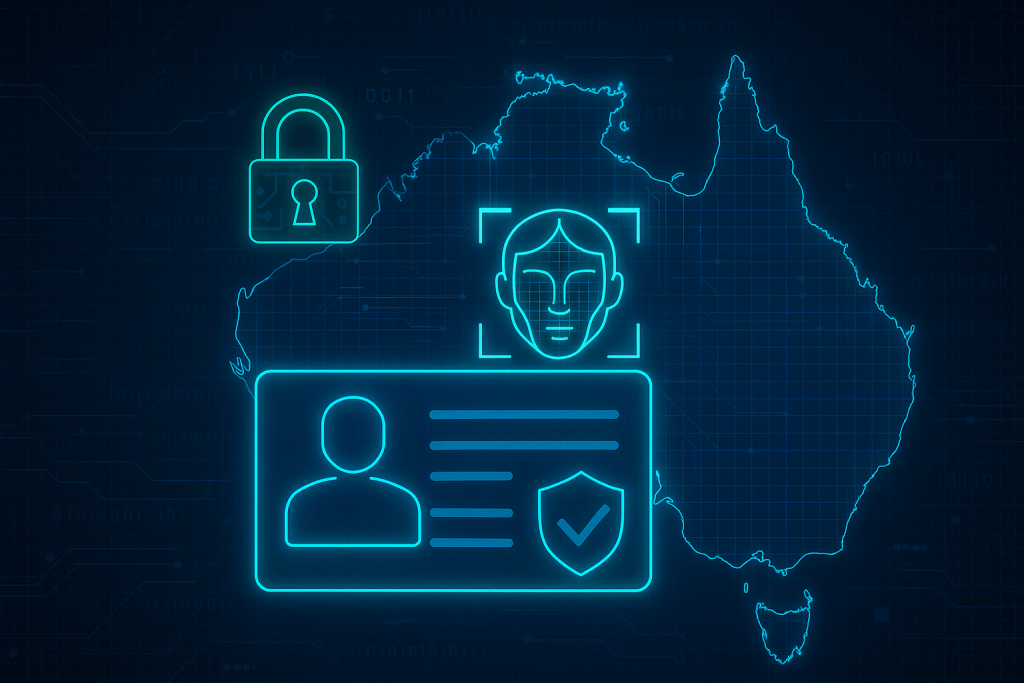2025 has been the year Australia moved from talk to action: Parliament passed a national Digital ID Act, regulators ran public trials, and the Social Media Minimum Age amendment to the Online Safety Act requiring platforms to verify users’ ages is taking effect in December.

What does that mean for you and your privacy? And will VPNs become a way of life in Australia? Let’s figure it out.
Age Verification in Australia
Online age assurance, like it or not, gradually becomes the new norm. Australia is no exception. Even more than that, it’s leading the charge with freshly adopted regulations that some call radical.
Australia’s Social Media Minimum Age amendment
In late 2024, Parliament adopted the Social Media Minimum Age amendment that complements Australia’s Online Safety Act and requires designated social media platforms to take “reasonable steps” to stop under-16s from creating accounts. The law takes effect in December 2025, and currently, the eSafety Commissioner website lists 9 platforms as subject to age restriction:
- X
- Kick
- Snapchat
- Threads
- TikTok
- YouTube
The law is not a ban on kids using the internet but an obligation on services. However, the approach raises questions from both platforms and parents. Google representatives expressed concern specifically about the AI-based age estimation, stating that it could be “unreliable and intrusive.”
Parents are more worried about the consequences: how the ban will affect the kids who rely on YouTube for educational purposes and the risk of them moving to “unsupervised or anonymous platforms.”
Phase 2 Online Safety Codes
Despite the vague name, the Phase 2 Codes regulation carries concrete implications for search engines, forcing them to implement age assurance technologies.
Starting from December 2025, Google, Bing, and other search engines, along with hosting services and internet carriage services, will have to check users’ age to “prevent children from accessing or being exposed to age-inappropriate material online.”
In 2026, it will also take effect for equipment providers, relevant electronic services, app distribution services, designated internet services, and social media services.
How age assurance will be implemented
Regulators aren’t pushing a single technology. Instead, platforms are expected to pick appropriate methods based on risk, accuracy, and privacy. Here are the main approaches listed in the regulations:
- Photo ID checks: You upload a government document (passport, driver’s license), which is checked against your supplied details. High assurance, but invasive—stores sensitive documents and increases breach and identity theft risks.
- Face-scanning age estimation: A selfie or short video is analyzed by AI to estimate whether the person looks over (or under) the threshold. It’s fast but probabilistic, biased for some groups, and can produce false rejections—or confirmations.
- Credit card checks: The service checks whether you have a valid payment card to confirm you’re an adult. Reliable but excludes unbanked users and links your financial signals to an online account—not very privacy friendly.
- Digital ID: A government-issued electronic identification that only shares a certain token, e.g., “over 16.” Best privacy in theory, as it only proves a single attribute without sharing full identity, but it largely depends on design.
- Vouching by a parent or guardian: A verified parent or guardian confirms a young user’s age via their own verified account. Useful where minors lack documents but raises questions about consent.
- AI-based behavioral signals: Algorithms infer age from device signals, typing patterns, browser fingerprints, content interaction, or other behavioral cues. It’s low friction and scalable, but not always accurate.
- Third-party checks: Accredited companies query authoritative databases (government records, credit bureaus, telephone companies) to confirm age. High coverage for platforms, but low privacy—such services centralize user data, which makes them attractive targets for breaches and cross-service profiling.
Digital ID in Australia
Age verification is only part of the story. The world is clearly moving toward a digital ID reality, and Australia is part of that shift. The concept of Australia’s digital ID is set out in the Digital ID Act 2024.
What is the Digital ID Act 2024
The Digital ID Act, passed in late 2024, establishes the Australian Government Digital ID System (AGDIS) and regulates the use of digital ID across the Commonwealth. So what is a digital ID in Australia, according to the document?
The Act defines it as a “distinct electronic representation of the individual that enables the individual to be sufficiently distinguished when interacting online with services.” In plain language, it’s a way to prove that you are you online.
The AGDIS has been in effect since November 2024, and government services are already using the system, while private entities will be able to apply for accreditation from December 2026.
Will the digital ID be mandatory in Australia?
That is the question many people ask—especially in countries where similar systems are being implemented. The Digital ID Act requires that there must always be alternative ways to prove your identity, so the use of the digital ID in Australia will be voluntary for now. However, the world and regulations are changing fast, so there’s no guarantee that the pressure to adopt it won’t grow over time.
Risks and Impacts for Users and Platforms
The goal behind the policy is clear—make kids safer—but what about side effects?
- Identity concentration. If everyone picks the same handful of verifiers, you end up with a single bucket holding millions of identity links—a high-value honeypot for criminals and a choke point for privacy. Who wants all their online life tied together in one place? Not many.
- Scope expansion. “Prove your age” today can become “prove your life” tomorrow. And convenience breeds reliance: platforms will prefer the simplest allowed verification flow—and that can push a de facto mandate, even without a law.
- Breach risks. A leaked password stings, but leaked biometrics are forever. Any system that stores faceprints or ID scans raises the stakes—the damage can’t be “reset” with a new password.
- Exclusion. Not everybody carries a current passport or a smartphone. Refugees, older people, low-income households, and people living offline risk being locked out unless platforms build assisted or offline paths.
- Market behavior. Platforms will chase the path of least resistance, favoring cheap, easy-to-implement methods. That can lead to vendor consolidation and predictable privacy harms. Also expect short-term spikes in VPN downloads every time ministers or headlines mention mandatory checks—people reach for quick control when they feel exposed.
How VPNs Can Help
Is it legal to use a VPN in Australia? Yes. Will a VPN help you bypass age assurance checks? It depends. A VPN is like a car’s tinted window—it may hide you in the traffic, but it won’t help at the police checkpoint.
Similarly, a VPN can hide where you’re browsing from and help bypass geoblocks, but it won’t stop services from asking for an ID if the requirement is platform-based.
- What VPNs actually do: They hide your IP address, encrypt your traffic, and can make you look like you’re browsing from another country. Useful for ISP-level privacy, remote work, and streaming geoblocked content.
💡 Quick tip: Types of VPN Explained: How Each Works and Which Is Best for You
- What they don’t do. A VPN won’t stop a site that asks for a passport, a selfie, or a digital ID. If you upload a document or use a digital wallet, a VPN can’t unring that bell.
- Don’t treat them as a cheat code. Using a VPN to dodge platform rules can violate terms of service, and platforms can and will deploy technical blocks and policy responses. And in some contexts, evasion could lead to real legal consequences.
- Tor vs. VPN. Tor offers stronger origin-hiding than typical consumer VPNs, but it’s still not a fix for a forced ID check.
If you use a VPN, pick a reputable provider with a verified no-logs policy and fast servers, and use it as one layer of privacy—along with separate accounts, good password hygiene, and two-factor authentication.
💡 Quick tip: How to Set Up a VPN at Home (Beginner-Friendly Guide)
What’s Next for Aussies?
Australia’s age verification and digital ID systems are an imminent reality, and regulations are likely to tighten. But that doesn’t mean you should just give away your privacy. Here’s what you can do:
- Read the fine print. Before you upload anything, check a platform’s retention and sharing rules—how long will they hold your ID? Who can see it?
- Prefer attribute attestation, not documents. If a service accepts a short attribute token instead of a passport scan, take it. Less data leaves fewer traces.
- Use a VPN. Keep one for network privacy and geoflexibility, but don’t rely on it to beat ID systems.
- Watch the pilots. Follow the eSafety updates to stay on topic and track new developments.
So what’s the likely future? Will we get selective, privacy-respecting verification; a convenience-driven model where a few vendors dominate; or something in-between? That will depend less on technology and more on choices platforms, regulators, and users make now.
FAQs
Does Australia have a digital ID?
Yes—Australia now has a government-backed digital identity framework established by the Digital ID Act 2024. Government services began using the system in 2024, and private entities will be able to apply for accreditation starting from December 2026.
Is a digital ID mandatory in Australia?
Not yet. The Digital ID Act requires alternatives to remain available, so the digital ID use will be voluntary for now. However, it’s likely that certain sector-specific checks (right-to-work, regulated services) may start requiring it in the future.
How does Australia’s age verification work?
There isn’t a single method. Currently, the regulators list a digital ID, photo and biometrics matching, AI-based behavioral signals, and credit card checks among acceptable verification options. Platforms are allowed to choose methods proportionate to risk.
Do I need a digital ID to use social media in Australia?
Not automatically. From December 2025 platforms must take “reasonable steps” to prevent under-16s from creating accounts, but that doesn’t necessarily mean a digital ID will be required—the method depends on the platform’s chosen approach.





